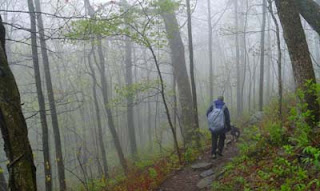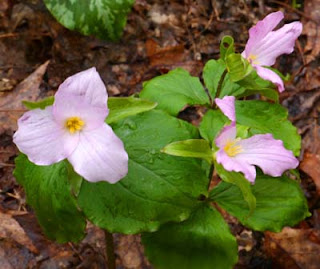 |
| Maya checking out the view near Clingman's Dome in the Great Smoky Mountain National Park |
Spruce-fir forest near top of Clingman's Dome
Many of the Fraser fir are dying because of an insect attack
All of our national parks are special places but it is especially touching that the states of North Carolina and Tennessee worked so hard to help create the Great Smoky Mountain National Park. In the 1920’s commercial logging was destroying the Appalachian forests. The citizens of North Carolina and Tennessee became alarmed and wanted to save some of their precious forests. Most of the land that eventually became the Smokies was private land and had to be purchased and donated to the federal government. So the people got busy and raised over half the money – even school children collected pennies and in 1934 the park was established.
Larger farm and home in Cades Cove
Because so much of the GSMNP was private land, that meant
many people were displaced from their homes.
Over two-thirds left the park. A
few were given lifetime leases on their places and some were given special
permits to allow them to stay on and farm.
But the regulations in the park made it really hard to stay on. People couldn’t hunt or cut firewood or even
farm in the ways they had known since childhood. Most eventually moved away and that was a sad
thing. Yet many of their farms, homes, barns,
mills and churches are preserved in the park for their children and
grandchildren and all of us to see how they lived in these beautiful mountains. The park not only protects amazing
Appalachian ecosystems but these historic structures as well.
I told David I must lack imagination because as I looked
at where the farmers had made their homes and fields I would have never thought
that it would be possible to build a house or grow corn on those steep slopes
with all those rocks and trees. Or maybe
we are all used to much easier lives.
Life may have been simpler about 160 years ago when the Smoky Mountains
were settled but there was nothing easy about it.
Methodist Church with two doors, one for men
and the other for women and children
Church interior
Our campsite at Elkmont Campground
Maya and David relaxing at camp
We spent 4 days at Elkmont Campground near the northern entrance of the park not far from Gatlinburg, Tennessee.
We had a beautiful riverside campsite and neighbor campers from
Texas. Who
would have thought we would have camping neighbors from Austin, TX right next to us?
Maya introduced us and we shared a few
fires and s’mores and bear stories. We
were excited because all of us saw mama bears and cubs in different places in the park!
Maya and Melissa, her new friend from Austin
After four days of exploring the northern end of the park we left for an overnight trip to Knoxville, Tennessee for some minor brake work on our Honda. While we were there one of David's friends from AT&T was traveling through Knoxville on vacation with his wife. So we arranged a lunch 'meet-up' with David W. and Sharon from San Antonio. They had been having a great time in Kentucky and were on their way to South Carolina. It was fun to catch up on all our travels and see friends from home.
We hadn't seen all we wanted of the Smoky Mountains yet, so we headed back to the park. The southern entrance to the park is right next to the Cherokee Indian Reservation. Many of us forget that before our ancestors made the Smokies their home, these mountains were part of Cherokee territory. The Cherokees have a rich history and many stories and legends centered in and around the park. We spent the better part of the next three days exploring this part of the park, the town of Cherokee, NC and the nearby Blue Ridge Parkway.
False Salomon Seal and Fern
Lady Slipper orchid
We hadn't seen all we wanted of the Smoky Mountains yet, so we headed back to the park. The southern entrance to the park is right next to the Cherokee Indian Reservation. Many of us forget that before our ancestors made the Smokies their home, these mountains were part of Cherokee territory. The Cherokees have a rich history and many stories and legends centered in and around the park. We spent the better part of the next three days exploring this part of the park, the town of Cherokee, NC and the nearby Blue Ridge Parkway.
Tiger swallow tail butterflies getting some minerals from the soil
David's Stats:
Days Hiked 5
Rain Days 2
Total Miles Hiked 9.07
Ave. Miles per Day 1.81
Total Elevation Gain 2,100
Ave. Elevation Gain per day 420
Days Hiked 5
Rain Days 2
Total Miles Hiked 9.07
Ave. Miles per Day 1.81
Total Elevation Gain 2,100
Ave. Elevation Gain per day 420














































